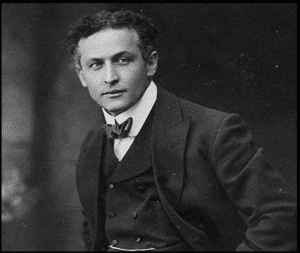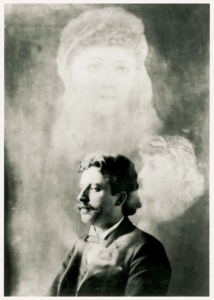DCPA NEWS CENTER
Enjoy the best stories and perspectives from the theatre world today.
Enjoy the best stories and perspectives from the theatre world today.
Whether you’re a fan of “The Mentalist” or “Psych” (my personal favorite), the world of mentalism is one of acute observation, sensory awareness, intuition, and good ol’ delivery. So when Mr. Memory in The 39 Steps astonishes crowds with his seemingly keen intellect, there may very well be more to it than being a human encyclopedia.
In fact, there are many types of mentalism that capture the imagination. Mentalism at its core is a performing art. Left at that description, the audience should expect a show. But, individuals throughout history have actually claimed some sort of supernatural ability, which often led to claims of fraud.

Harry Houdini
Taken at face value, mentalism as performance art generally falls into three categories:

Mentalist J. Randall Brown
Mentalism was first recorded in 1572 when magician Girolamo Scotto performed sleight-of-hand tricks and grew in popularity into the 1800s when John Randall Brown became the first mentalist to perform a mind-reading act for a live audience. While the days of circus sideshows are over, some mentalists continue to draw large crowds at popular destinations such as Las Vegas or on competitions including “America’s Got Talent.”
But what tricks do you have to have up your sleeve to achieve that level of acclaim in society today, where every move is recorded, dissected, and analyzed to discover reveal the deception?
According to several sources, there are three ways to hone your abilities:
When you’re ready to experiment, give these tricks a try:
GRAY ELEPHANTS FROM DENMARK
Courtesy of mantelligence.com
HOW DOES IT WORK? Starting with questions 1 and 2, their final answer will always be 4 no matter what. After that, this trick relies on playing probabilities, meaning just choosing the most likely answer. Since you know that most people would pick Denmark and elephant, you can seem like you can read minds.
THE INVISIBLE DICE
Courtesy of magicmentalism.com
For this particular trick, you’re going to have to memorize a short equation. Here are the steps to tricking everyone using the Invisible Dice method:
HOW DOES IT WORK? For you to guess properly, all you have to do is subtract 25 (-25) from their answer. The two digits of the answer you come up with are the numbers they started with. For example, let’s say they picked the numbers 4 and 3.
PREDICTION ALWAYS MATCHES
Courtesy of mentalismguide.com
HOW DOES IT WORK: What no one knows is that you will have pre-made a simple envelope with a fake back on it, so you can hide the card you are going to predict (which will, of course, match your prediction), and you are going to hide the card the volunteer chose behind that false back. Watch the video for full details.
